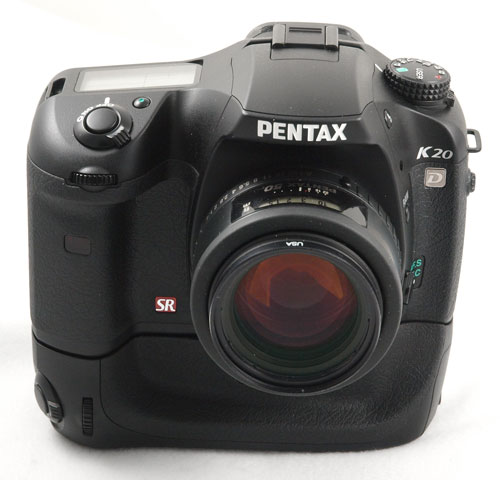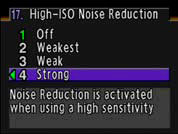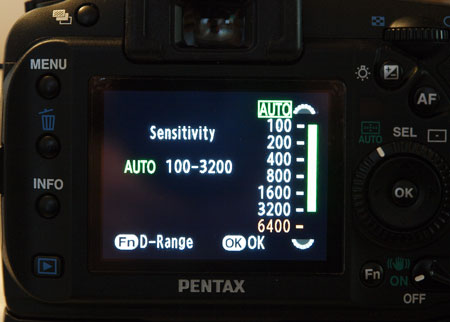Resolution and Image Quality

Our early impressions of the K20D were pretty positive with the fast Pentax 50mm f1.4. As always with recent screw-drive AF, the lens focusing is reasonably fast (if not blistering) and noise is much greater than the excellent Canon Ultrasonic motor lenses - which are now most of the better lenses in the Canon line. We had a K10D for comparison and the K20D seemed faster in AF, even though Pentax makes no claim of improvements in AF with the K20D.
The 14.6 MP CMOS sensor actually allows an ISO Boost to 6400, so the new ISO 3200 and ISO 6400 were the next features to tackle. By default the K20D high ISO noise reduction is set to off. This resulted in usable but grainy images at ISO 3200 and an ISO 6400 performance that was too coarse to be useful for our needs.

However, with the "weakest" and "weak" high ISO Noise Reduction settings, our first impressions in pixel-peeping high ISO images was much more favorable. The images with a small amount of noise reduction were pretty good - much better than we had expected. We had to wonder if early reviewers had noticed that high ISO noise reduction is completely off by default.
Images to ISO 1600 were quite good; 3200 shows deterioration in the shadow areas, but it is still very usable - even for large prints. ISO 6400 quality is better with a little NR and it would be usable for smaller prints or the web-posting we do, but too much is lost for large prints. All in all this is an outstanding performance for the new Samsung 14.6 MP sensor. Like many others, we wondered how good a new sensor from Samsung could be compared to Canon, Nikon, and Sony. More testing will be done in this area, but our first impressions are that the Samsung sensor is quite competitive, capturing more detail than the competing Nikon, Sony, Olympus, and Canon prosumer models.

Auto can be set to any ISO range you want, a feature Canon still refuses to implement fully. Based on early test shots we wouldn't hesitate to set the auto range from 100-1600 on a routine basis and 100-3200 if we were going into a low-light situation - or for times when the highest possible shutter speed is required. We would reserve 6400 for those special situations where the trade-offs make it worthwhile.
Whenever there is a recent Pentax is in our hands, we are again reminded of the usefulness of Hyperprogram, where you can instantly shift the aperture or shutter speed (front and rear dials) with the camera shifting other program parameters. Like the K10D, the K20D continues the unique TAv (Time & Aperture) Priority program, where you can select the shutter speed and the aperture which remain fixed while the program dynamically changes the ISO to maintain shutter speed and aperture. Selectable Auto ISO to 6400 on the one hand, and both TAv and Sv (Sensitivity or ISO) programs with the same range on the other hand, make the K20D a remarkably flexible digital SLR.










50 Comments
View All Comments
lol101 - Tuesday, March 11, 2008 - link
The HypP mode is different from the program shift that you can find on other manufacturer's models.In HypP mode, when you select an aperture, you're effectively going to Av mode, meaning that the camera will keep the selected value for all subsequent shots and adapt the shutter speed.
Same goes for selecting a shutter speed that gets you in Tv mode.
Each time, the selected parameter is underlined in the VF so that you always know which parameter is dominant.
If at some point you decide you want to hand control back to the camera (ie switch back to P mode), you just have to press the green button.
Simple, usefull and very efficient.
dug777 - Tuesday, March 11, 2008 - link
I appreciate that, but what you've both described is what happens in A & S Priority for Nikon (*screams*).In A priority, you select an aperture, and the camera picks the shutter speed. The aperture does not change until you change it (ewven if you turn the camera off. You know Aperture is dominant because you've turned a dial to set 'A' for aperture priority.
Vice versa for shutter priority.
All HyP appears to do is allow you to go directly into A or S (and effectively full manual if you do both), without turning a dial.
You do however need to press a button to go back to full P. So it saves you that initial click. But it does sound pretty handy, and easy to use.
Unless I'm missing something blindingly obvious, in which case I sincerely apologise for wasting your time :o
lol101 - Tuesday, March 11, 2008 - link
Yes, the only thing the HyP mode allows you to do is switch between P, Tv or Av without having to stop shooting to switch some dial.It may look like a small subtlety but I can assure you it just makes the photographer's life easier.
It's instantaneous and the camera just doesn't get in your way when faced with changing conditions and that's what's interesting about it.
I use both Pentax and Canon systems and still cannot understand why Pentax are the only one to implement such things as HyP (or even better: HyM mode) or to allow the user to set the ISO directly with some dial and use one button press to go to auto ISO.... these are just things that make you forget about the camera while shooting and being able to control everything without ever leaving the VF from the eye.
The 'philosophy" is rather simple IMO: give the photographer a way to adjust any shooting parameter (shutter speed, aperture or ISO) when he wants it and without having to bother about pressing a dedicated button or changing a mode dial.
Heidfirst - Wednesday, March 12, 2008 - link
I suspect that Pentax aren't the only ones to give that functionality but probably are the only ones to do so in that exact way.Minolta (now Sony of course) were always thought of as cameras designed by photographers for photographers (Canon are designed by engineers for marketing :P) - I suspect that theirs & Pentax design ethos are very similar.
Heidfirst - Tuesday, March 11, 2008 - link
Pentax & Minolta/Sony (& probably others) have full A & S priority modes as well though.Going by a later, fuller description of HyperProgramme it does seem to have slightly more than Minolta/Sony's implementation although I would argue that at least some of that secondary ability is covered by user ability/knowledge (I assume that most users of that level of camera have some experience & appreciation of the effects of aperture & shutter) as I'm sure that you would with Nikon.
On my A700 I have Auto, Programme (3 versions), assorted scenes modes (which I suspect also largely covers the secondary abilities of Hyperprogramme), aperture priority, shutter priority, 3 memory settings & of course full manual - a bit of overkill imo.
It's not surprising that I see more people eschewing automation & going back to doing more manually.
Wesley Fink - Tuesday, March 11, 2008 - link
The K20D also has Sv (sensitivity), Tv (shutter), and Av (Aperture) Prioriy programs. Theres is also a very interesting and unique Mode called the TAv (time & aperture priority). In TAv mode shutter speed (time) and aperture are fixed and only the ISO is automatically adjusted for the proper exposure. The camera adjusted ISO is displayed in the viewfinder and blinks if the exposure is out of range. Shutter can be adjusted with the front dial and aperture with the rear dial.There are some situations where you might require a certain aperture for depth of field and at least a certain shutter speed to prevent blur and that is where the TAv mode could be very useful. As far as I know the K20D and K10D are the only SLR cameras with anything like the TAv Program.
Heidfirst - Tuesday, March 11, 2008 - link
Minolta/Sony seems very similar - you actually have 3 Programme modes (as well as full Auto) incl. Pa & Ps where the camera will remember the adjusted setting for future shots & vary the other to compensate as the lighting changes.Wesley Fink - Tuesday, March 11, 2008 - link
Most manufacturers do have variants of the hyperprogram feature and I've used almost all of them. However this Pentax feature is still one of the easiest to use and most flexible when you add the unique Sensitivity Priority program.dug777 - Tuesday, March 11, 2008 - link
Regarding my description of the Nikon D80 system, how exactly is it easier?As far as I can see it's effectively identical (and incredibly easy to use).
Wesley Fink - Tuesday, March 11, 2008 - link
See lol101's description of Hyperprogram below or my detailed desription on page 2 for more info on the specifics of how Pentax Hyperprogram works.